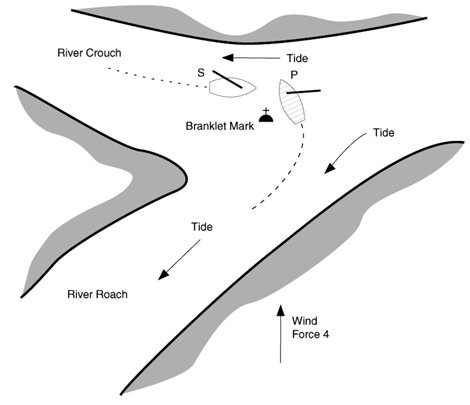(This is an instalment in a series of blogposts about the ISAF Case book 2009-2012 with amendments for 2010. All cases are official interpretations by the ISAF committees on how the Racing Rules of Sailing should be used or interpreted. The cases are copied from the Casebook, only the comments are written by me.)
CASE 26
Rule 14, Avoiding Contact
Rule 16.1, Changing Course
Rule 18.1, Mark-Room: When Rule 18 Applies
A right-of-way boat need not act to avoid a collision until it is clear that the other boat is not keeping clear. However, if the right-of-way boat could then have avoided the collision and the collision resulted in damage, she must be penalized under rule 14.
Summary of the Facts
A Soling, S, and a 505, P, in separate races, approached the same mark on opposite tacks. Unknown to P, which was lowering her spinnaker and hardening up to leave the mark to port, S was required to leave it to starboard and was preparing to do so.

P heard no hail and was unaware of S’s presence until the boats were in the positions shown in the diagram, at which time P’s crew saw S. He shouted a warning and leaped out of the way just as S’s bow struck P’s hull behind the mast, causing damage.
P protested S under rule 14 on the grounds that S could have avoided the collision. S and two witnesses testified that S did not at any time change her course before the collision. S, protesting under rule 10, claimed that if she had changed course she would have broken rule 16.1. The protest committee disqualified P under rules 10 and 14. P appealed.
Decision
P, as the keep-clear boat, failed to keep a lookout and to observe her primary duties to keep clear and avoid contact. She broke both rule 10 and rule 14. An important purpose of the rules of Part 2 is to avoid contact between boats. All boats, whether or not holding right of way, should keep a lookout at all times.
Rule 18 did not apply because S and P were not required to leave the mark on the same side (see rule 18.1). When it became clear that P was not keeping clear, S was required by rule 14 to act to avoid contact with P (see rule 14(a)). Before the positions shown in the diagram it became clear that the boats were on converging courses and that P was not keeping clear. At that time S could have luffed and avoided contact with P. Such a change of course by S would have given P more room to keep clear and would not have broken rule 16.1. The contact caused damage. Therefore, S broke rule 14 and must be penalized for having done so (see rule 14(b)).
P was correctly disqualified under rules 10 and 14. S is also disqualified, for breaking rule 14.
RYA 1971/4
![]()
Firstly, this has been in the callbooks since 1974, more than 35 years. The basic premise – avoiding contact – has been well established in the racing world. We as PC members have sometimes a little skewed image of this, because we tend to interact in the ‘room’ with boats (and sailors) when they do not follow this.
Secondly, what kind of &(^$%^^& Race Committee would allow a regatta with a mark that allows Port and Starboard roundings at the same time? That is asking for trouble.
It does however neatly illustrates the point that all boats approaching a mark have the tendency to focus exclusively on that rounding – forgetting all other issues. That kind of focus might be needed to do all the necessary tasks, but does not relieve a boat of keeping an adequate look-out.
Finally, rule 14 has a yes/no clause if it comes to penalizing the right-of-way boat (or the one entitled to room or mark-room). This yes/no clause is triggered by if there’s damage or not.
No damage = no penalty and Yes damage = yes penalty.
Many sailors confuse this damage in rule 14 with the damage in rule 44.1. However, for rule 14 the damage does not have to be ‘serious’, as it does in rule 44.1.
Any scratch, nicked paint, dent or whatever, that a prudent owner would repair immediately or in the near future, can be damage. If it is so little that it only gets repaired in the next scheduled winter overhaul or paintjob, then – in my opinion – it is not damage triggering rule 14.
Ooh, to be complete, the yes/no clause is also triggered by injury! ANY injury, even if it only needs a band-aid to be able to sail on.


Could it be that the two races were organised by different race committees at different clubs? Quite possible in the congested estuaries around Britain. Mindyou, I'm not sure how you would establish which race organisation would be the correct one to file the protest with- it's a nightmare of jurisdiction.
ReplyDeleteWhilst there is cooperation between neighbouring clubs, it can break down, especially if a further off club is holding a longer distance race.
It has happened in the past, otherwise it would not have been in the casebook.
DeleteI can't speak for the UK but here at home we coordinate our regatta's in a year calendar and the provincial government only gives permission if they are satisfied they don't overlap to create unworkable situations. I.e. two different regattas on the same day on the same water.
The situation arises (or at least arose when, a long time ago, when I sailed there) frequently on the Crouch as the Branklet is the only sensible mark option to get boats from the Crouch up in to the Roach, and provide something approaching a beat. All part of the fun since 1893.....!
ReplyDeleteGordon